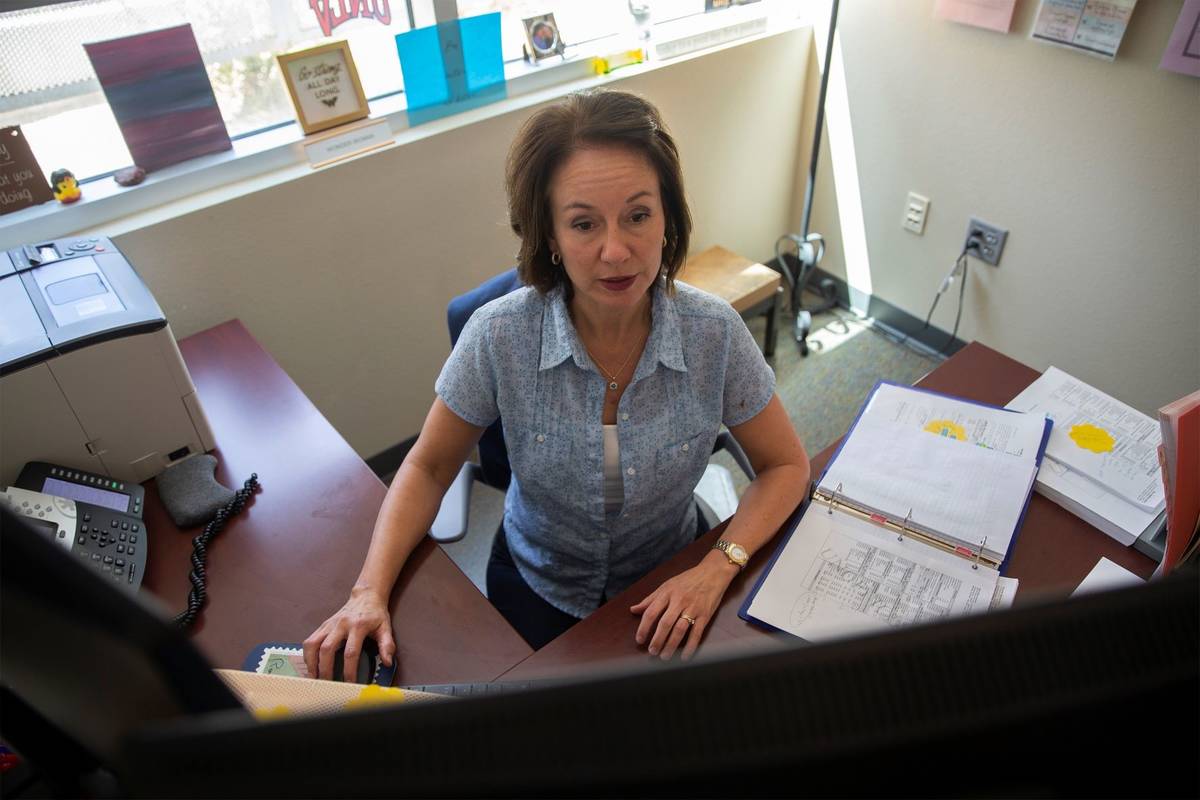Online enrollment surges at CCSD in early days of school year
Enrollment at the Clark County School District’s sole online-only school has jumped more than 68 percent since the school year began this month amid high COVID-19 metrics and near daily reports of exposures on campuses around the Las Vegas Valley.
Nevada Learning Academy at CCSD had 7,080 students enrolled as of Monday morning. That’s more than 2 percent of the district’s total of approximately 308,000 students.
The learning academy had about 4,200 students enrolled as of Aug. 9, the first day of the fall semester, and has added nearly 3,000 students since, Principal Michael Martin said.
Last year, the school had approximately 450 full-time students in third through 12th grades. But the school added kindergarten through second grades this year, so it’s not an apples-to-apples comparison.
Applications continued to pour in last week, prompting Martinl to predict that final enrollment might grow by a few hundred more students.
Schools across the nation are working this year to help students who may have fallen behind academically — in some cases, due to challenges with adapting to a distance education format — during the last school year.
While more data is needed to determine the level of what experts are calling pandemic-related learning loss in Clark County, at least one indicator suggests it was a serious issue.
During spring semester, 44 percent of students across the school district had at least one D and 39 percent had at least one F in a class — much higher percentages than in past years.
School district representatives did not provide a total number of students enrolled in distance learning overall this semester by deadline on Monday — a week after the Review-Journal requested the information. In addition to Nevada Learning Academy, 12 district schools are providing their own virtual options.
Scramble for resources
District officials have not fully explained what they intend to do differently this year to improve the remote instruction experience, but part of the plan involves shifting resources to Nevada Learning Academy to help it shoulder the load that comes with being the backbone of the district’s program.
That has the school, which began operating in the early 2000s, “trying to get as much support as possible from the school district,” Martin said.
It’s been a challenge, he said, but administrators know how important the school is and are working hard to ensure that it is able to meet student needs. Among other things, additional staff such as secretaries, counselors and project facilitators have been shifted from other schools to help out, Martin said.
The district also is expected to use the “surplus process ” this fall to reassign more teachers to the academy and other schools in response to enrollment numbers and staffing needs.
Currently, the school has approximately 180 teachers.
Martin said there have been some opening challenges — particularly, since enrollment grew so quickly — but parents have been amazing.
“There’s a ton of positivity,” he said of the atmosphere during the first two weeks.
He said some families are choosing the school this year due to COVID-19 concerns, but not all.
“For others, they just feel their students are more comfortable in the distance learning environment,” Martin said.
The school district operated under full distance education for about a year beginning in March 2020 due to the pandemic before resuming in-person classes in the spring.
Since the return, schools across the valley have reported numerous COVID-19 cases and exposures.That includes school district campuses such as Foothill High School, O’Callaghan Middle School i3 Learn Academy and Lamping Elementary School, where all teachers and students were switched to distance education after multiple individuals at the Henderson school tested positive.
Public charter schools affected include Signature Preparatory and Coral Academy of Science Las Vegas’ Windmill campus.
One parent’s experience
Kerryann Drace had a different reason for turning to online education for her son, a high school senior.
The teen has attention-deficit/hyperactivity disorder (ADHD) and struggles with anxiety, which has gotten progressively worse with every year of high school, beginning with panic attacks when he was a sophomore, she said.
On the first day this year at his traditional high school, her son felt it was crowded in the hallways. Some students weren’t wearing masks properly and he didn’t feel safe, she said.
He’s vaccinated, but “he’s one of those kids who’s really careful,” his mom said.
By the end of the second day of school, it was clear things weren’t working, so she went online and registered him for Nevada Learning Academy.
Her son had taken a few summer classes through the online school and had experience with distance education due to the pandemic, Drace said.
“He’s pretty much working at his own pace,” she said, noting that she isn’t concerned about the larger class sizes at the school for that reason. “I think it’s a good option.”
Bridger Middle School in North Las Vegas, one of the dozen district campuses offering a full-time distance education option, has seen an opposite enrollment trend from Nevada Learning Academy.
About 180 Bridger students requested distance education in the spring, a number that had dwindled to 85 by last week.
Principal Ramona Fricker said the fact that parents had to decide so early between in-person and distance learning gave them plenty of time to change their minds.
“We had some students who showed up on the first day,” she said. “They had changed their mind to come back to face-to-face.”
In total, 14 teachers are involved with distance education, only one full time. The rest teach one or more class sections online and the rest face to face.
Pre-enrollment conversations
Fricker said she thinks the biggest hindrance to online education is the need to have support at home, so school officials looked at each request to see how the student performed when working in the format last year. If the student didn’t make adequate process, school counselors and administrators reached out to talk with their parents to suggest that distance learning might not be a good fit, she said.
“We wanted to make sure that students are able to be successful,” Fricker said.
The school isn’t able to offer classes such as dance, band and hands-on magnet programs online, she said. And Fricker said the school doesn’t have the staffing to accommodate students with an Individualized Education Program (IEP) through distance education.
There have been a couple of hiccups with distance education so far this school year but “nothing real urgent,” Fricker said.
The district has done a good job providing resources for distance education, she said. And with fewer students using the district’s course management system, Canvas, at any given time, she noted, there have been fewer hiccups and system crashes.
Distance education students at Bridger are allowed to come on campus for lunch, sports and other activities if they choose. There’s also a mentorship hour that allows them to get extra support, such as meeting with a counselor.
The school is trying to figure out online activities it could offer a couple of days a week to ensure distance education students are getting social interaction, Fricker said.
“Overall, I think it’s a really good opportunity for some of our families,” she said, noting some students have done extremely well academically with distance education.
Contact Julie Wootton-Greener at jgreener@reviewjournal.com or 702-387-2921. Follow @julieswootton on Twitter.
















































